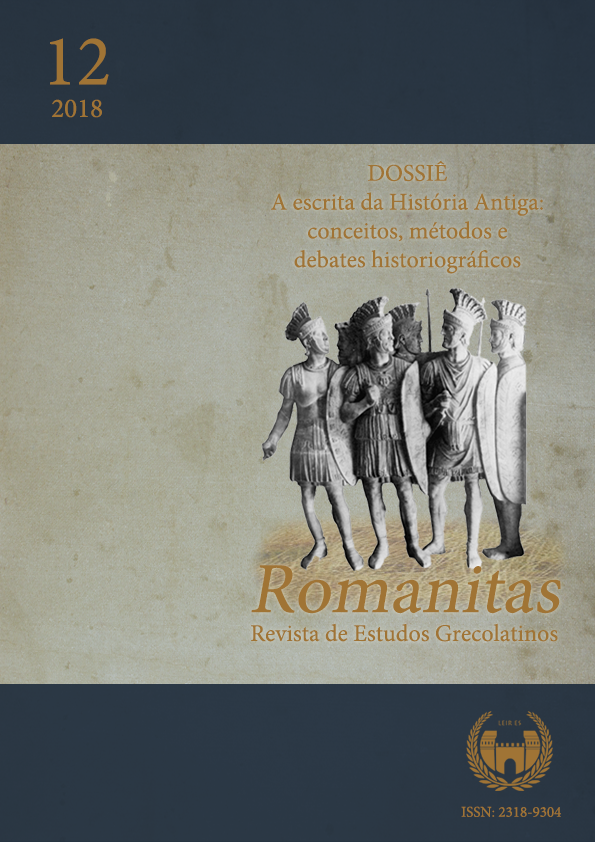Digital technologies and mapping of social networks for the study of Antiquity: the Festival of the ‘Compitalia’ and its social actors in Augustan Rome
DOI:
https://doi.org/10.17648/rom.v0i12.23526Keywords:
Compitalia, Social network, Magistri uici, Late Republic, Digital ClassicsAbstract
Today, most efforts to compile and share documents related to the Ancient World have technology as an ally. In both digital mapping and the inclusion of epigraphic, numismatic and iconographic documents on open access platforms, digital technology is essential for scientific work on Antiquity. This article, which seeks to address this question, is divided into two parts: a theoretical one, aimed at understanding how the Digital Classics area underlines one of the great current additions to the Humanities, which is digital technology; and another methodological one, in which the methods with their selections and choices that allow the creation of a map of the network are presented. As a case study, we present the problem of the network of connections built from the contact between Augusto and the magistri uici and the production of everyday religious actions and interactions, as well as the partial results of the reconstruction of the map developed by Digital Augustan Rome to reach our goal of demarcating a network over it.
Downloads
References
Documentação textual
CICERO. Pro Milone. In Pisonem. Pro Scauro. Pro Fonteio. Pro Rabirio Postumo. Pro Marcello. Pro Ligario. Pro Rege Deiotaro. Translated by N. H. Watts. Cambridge: Harvard University Press, 1931.
DIO CASSIUS. Roman History: Books 51-55. Translated by Earnest Cary and Herbert B. Foster. Cambridge: Harvard University Press, 1917. v. VI.
PLINY. Natural History: Books 1-2. Translated by H. Rackham. Cambridge: Harvard University Press, 1938. v. I.
Documentação arqueológica e visual
ARACHNE. German Archaeological Institute. Archaeological Institute of the University of Cologne. Available in: <https://arachne.uni-koeln.de/drupal/>.
DIGITAL AUGUSTAN ROME. University of Arizona, Archaeological Mapping Lab. Available in: <http://digitalaugustanrome.org/>.
FORMA URBIS ROMAE. Stanford Digital Forma Urbis Romae Project. Available in: <https://formaurbis.stanford.edu/>.
VICUS STATAE MATRIS. Roma, Musei Capitolini, Centrale Montemartini, inv. 2144.
Obras de referência
COARELLI, F. et al. Lexicon topographicum urbis Romae: Gli scavi di Roma, 1922-1975. Roma: Quasar, 2006. s. II.2.
COARELLI, F. Lexicon topographicum urbis Romae: Gli scavi di Roma 1878-1921. Roma: Quasar, 2004. s. II.1.
PLATNER, S. B. A topographical dictionary of ancient Rome. Completed and presented by Thomas Ashby. London: Humphrey Milford; Oxford University Press, 1929.
RICHARDSON Jr., L. A new topographical dictionary of ancient Rome. Baltimore: Johns Hopkins University Press, 1992.
STEINBY, E. M. (Ed.). Lexicon topographicum urbis Romae: A-C. Roma: Quasar, 1995a. v. 1.
STEINBY, E. M. (Ed.). Lexicon topographicum urbis Romae: D-G. Roma: Quasar, 1995b. v. 2.
STEINBY, E. M. (Ed.). Lexicon topographicum urbis Romae: P-S. Roma: Quasar, 1999. v. 4.
STEINBY, E. M. (Ed.). Lexicon topographicum urbis Romae: T-Z. Roma: Quasar, 2000. v. 5.
Obras de apoio
ALEXANDER, M.; DANOWSKI, J. A. Analysis of an ancient network. Personal communication and the study of social structure in a past society. Social Networks, n. 12, p. 313-335, 1990.
COARELLI, F. Rome and environs: an archaeological guide. California: University of California Press, 2007.
CRANE, G. Classics and the computer: an end of the History. In: SCHREIBMAN, S.; SIEMENS, R.; UNSWORTH, J. (Ed.). A Companion to Digital Humanities. Oxford: Blackwell, 2004, p. 46-55.
FAVRO, D. Making Rome a World City. In: GALINSKY, K. (Ed.). The Cambridge Companion to the Age of Augustus. New York: Cambridge University Press, 2005, p. 234-263.
FAVRO, D. The urban image of Augustan Rome. Cambridge: Cambridge University Press, 1996.
FLOWER, H. The Dancing Lares and the Serpent in the Garden: religion at the Roman street corner. Princeton: Princeton University, 2017.
GRADEL, I. Emperor worship and Roman religion. Oxford: Oxford University Press, 2002.
HASELBERGER, L. Urbem Adornare: Rome’s urban metamorphosis under Augustus. Portsmouth: Journal of Roman Archeology, 2007.
HOCKEY, S. The History of Humanities Computing. In: SCHREIBMAN, S.; SIEMENS, R.; UNSWORTH, J. (Ed.). A Companion to Digital Humanities. Oxford: Blackwell, 2004, p. 1-19.
HÖLKESKAMP, K.-J. Reconstructing the Roman Republic: an ancient political culture and modern research. Princeton: Princeton University Press, 2010.
LOTT, J. B. The neighborhoods of Augustan Rome. New York: Cambridge University Press, 2004.
TAN, J. Publius Clodius and the boundaries of the contio. In: STEEL, C.; VAN DER BLOM, H. (Ed.). Community and communication: oratory and politics in Republican Rome. Oxford: Oxford University Press, 2013, p. 117-132.
WOOLF, G. Only connect? Network analysis and religious change in the Roman World. Hélade, v. 2, n. 2, p. 43-58, 2016.
ZANKER, P. The power of images in the Age of Augustus. Michigan: University of Michigan Press, 2010.
Downloads
Published
How to Cite
Issue
Section
License
Copyright (c) 2019 Romanitas - Revista de Estudos Grecolatinos

This work is licensed under a Creative Commons Attribution-NonCommercial-NoDerivatives 4.0 International License.
a. The authors retain copyright and grant the journal the right to first publication.
b. The authors are authorized to assume additional contracts separately, for non-exclusive distribution of the version of the work published in this journal (e.g., publishing in institutional repository or as a book chapter), with acknowledgment of authorship and initial publication in this journal.
c. Authors are allowed and encouraged to publish and distribute their work online (e.g. in institutional repositories or on their personal page) after the first publication by the journal, with due credit.
d. The journal's texts are licensed under a CC BY 4.0 Deed Attribution 4.0 International Licence (CC BY).




























